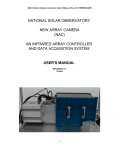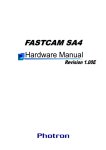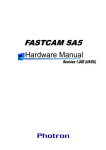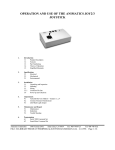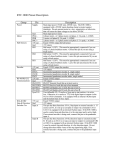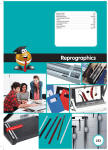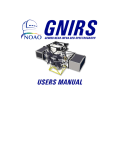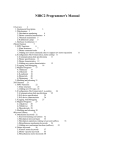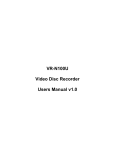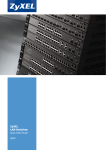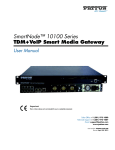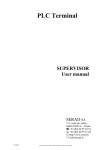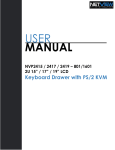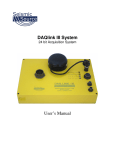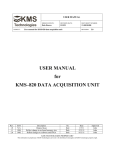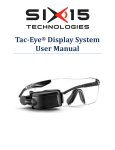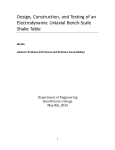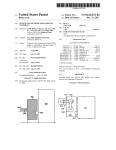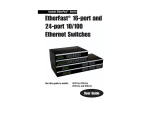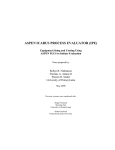Download Operator`s Manual
Transcript
NSO NAC Operator's Manual Rev 0.11 PRELIMINARY NATIONAL SOLAR OBSERVATORY NEW ARRAY CAMERA (NAC) AN INFRARED ARRAY CONTROLLER AND DATA ACQUISITION SYSTEM OPERATOR'S MANUAL REVISION 0.12 3/8/05 Prepared by Mauna Kea Infrared, LLC -1- NSO NAC Operator's Manual Rev 0.11 PRELIMINARY Revision History Revision Author 0.12 Mike Thompson 0.11 Mike Thompson 0.10 Mike Thompson Summary of revisions Date Added Mechanism Control Subsystem as a related document. Made the IC Electronics block diagram more hip with 3-D shapes. Updated Pixel Server G3 info. 3/8/05 (This version contains unresolved issues and questions. Action items and questions for Doug are marked TODO DT and ???.) General proofread. Added IC Engineering Interface addendum reference. Wrote Instrument Description. Added mechanical description. Added Mechanism and Electronics Troubleshooting content. Wrote Mechanical Specifications and added Power Estimates. Initial revision. Mostly this is a template, but some details and procedures have been written. More work to follow immediately. Added entrance window pictures and procedures. -2- 3/3/05 2/17/05 NSO NAC Operator's Manual Rev 0.11 PRELIMINARY 1 Table of Contents Introduction ............................................................................................................. 6 1.1 2 Related Documents...........................................................................................................................6 Safety ....................................................................................................................... 7 2.1 Recommended Training ....................................................................................................................7 2.2 Mechanical Handling Precautions.....................................................................................................7 2.2.1 Tipping hazard ...........................................................................................................................7 2.2.2 Sweeping when Rotating ...........................................................................................................7 2.2.3 Falling Tool Hazard ....................................................................................................................7 2.3 Cryogenic System Precautions .........................................................................................................8 2.3.1 Cryogen handling .......................................................................................................................8 2.3.2 Nitrogen suffocation hazard .......................................................................................................8 2.3.3 Disconnecting Cold Head ..........................................................................................................8 2.3.4 Ice Plug in Pre-charge Neck ......................................................................................................8 2.4 Compressed Gas ..............................................................................................................................9 2.4.1 Compressed gas ........................................................................................................................9 2.4.2 Compressed Gas Transportation...............................................................................................9 2.5 Electrical System Precautions...........................................................................................................9 2.5.1 Electrical shock hazard ..............................................................................................................9 2.5.2 Cabling .......................................................................................................................................9 2.6 Vacuum Precautions .........................................................................................................................9 2.7 Areas of Risk to the instrument .......................................................................................................10 2.7.1 Vacuum leaks...........................................................................................................................10 2.7.2 Optical Surfaces.......................................................................................................................10 2.7.3 Cleanliness, Dust, and Optics..................................................................................................10 2.7.4 Array.........................................................................................................................................10 2.7.5 Array Control Electronics Boards are not VME Cards .............................................................10 2.7.6 Static Discharge .......................................................................................................................10 3 Instrument Description......................................................................................... 11 3.1 Major Assemblies Description.........................................................................................................12 3.2 Optics and Light Path Description...................................................................................................13 3.3 Instrument Control Electronics Description .....................................................................................15 3.3.1 Instrument Control Electronics Theory of Operation................................................................15 3.3.2 Cabling Description ..................................................................................................................17 3.3.3 Mechanical Specifications........................................................................................................18 3.3.3.1 Mechanical Dimensions and Part Numbers .....................................................................18 3.3.3.2 Weight ...............................................................................................................................18 3.3.4 Power Dissipation Estimates ...................................................................................................19 3.4 Cryostat Description ........................................................................................................................20 3.5 Spares List.......................................................................................................................................21 4 Instrument Preparation and Installation ............................................................. 22 4.1 Vacuum and Cryogenic Procedures ...............................................................................................22 4.1.1 Evacuation of NAC...................................................................................................................22 4.1.1.1 Preparation and Special Equipment .................................................................................22 4.1.1.2 Pumping on an Existing Vacuum......................................................................................22 4.1.1.3 Pumping Down from Ambient Pressure ...........................................................................22 4.1.1.4 Pumping Down after Disassembly....................................................................................22 4.1.2 Cryo-cooler Operation..............................................................................................................23 4.1.2.1 Connecting Helium Supply and Return Lines...................................................................23 4.1.2.2 Cryo-Cooler Start-Up ........................................................................................................24 4.1.2.3 Cryo-Cooler Shutdown .....................................................................................................24 4.1.3 Cool-Down with Pre-Cool.........................................................................................................25 4.1.3.1 Safety ................................................................................................................................25 4.1.3.2 Preparation .......................................................................................................................25 4.1.3.3 Cryo-Cooler Start-Up ........................................................................................................25 -3- NSO NAC Operator's Manual Rev 0.11 PRELIMINARY 4.1.3.4 Pre-Cool Start ...................................................................................................................25 4.1.3.5 Pre-Cool Stop ...................................................................................................................25 4.1.3.6 Pre-Cool Purge and Backfill..............................................................................................25 4.1.3.7 Final Cooling with Cryo-Coolers .......................................................................................25 4.1.4 Cool-Down without Pre-Cool....................................................................................................26 4.1.4.1 Safety ................................................................................................................................26 4.1.4.2 Preparation .......................................................................................................................26 4.1.4.3 Cryo-Cooler Start ..............................................................................................................26 4.1.4.4 Cryo-Cooler Cool-Down....................................................................................................26 4.1.5 NAC Warm-Up Procedures......................................................................................................27 4.1.5.1.1 Safety ............................................................................................................................27 4.1.5.1.2 Theory of Operation ......................................................................................................27 4.1.5.1.3 Operation ......................................................................................................................27 4.1.6 Instrument Pressurization to Atmospheric Pressure ...............................................................28 4.1.7 Back-Filling the Instrument Prior to Maintenance ....................................................................28 4.2 Electronics and Software Start-Up and Shutdown..........................................................................29 4.2.1 Electronics Power Up...............................................................................................................29 4.2.2 Software Start-Up.....................................................................................................................29 4.2.3 Electronics and Software Shutdown ........................................................................................29 4.2.4 Electronics Power Down ..........................................................................................................29 4.3 Standalone and Remote Operation.................................................................................................29 4.4 Engineering Password ....................................................................................................................29 5 Maintenance Procedures...................................................................................... 30 5.1 Maintenance Intervals .....................................................................................................................30 5.2 Cryo-Cooler Maintenance ...............................................................................................................31 5.2.1 Cryo-head Purge and Decontamination ..................................................................................31 5.2.2 Cryo-head (Drive Unit) Removal..............................................................................................31 5.2.3 Cryo-head (Drive Unit) Installation...........................................................................................31 5.3 Entrance Window Maintenance ......................................................................................................32 5.3.1 Entrance Window Inspection ...................................................................................................32 5.3.2 Entrance Window Cleaning......................................................................................................33 5.3.2.1 Light Window Cleaning for Light Contamination (dust, lint)..............................................33 5.3.2.2 Moderate Window Cleaning for Moderate Contamination (smudges, fingerprints) .........34 5.3.3 Entrance Window Removal......................................................................................................34 5.3.4 Entrance Window Installation...................................................................................................34 5.3.5 Entrance Window Cover ..........................................................................................................35 6 Troubleshooting.................................................................................................... 36 6.1 Cooling System Diagnostics ...........................................................................................................36 6.2 Vacuum Troubleshooting ................................................................................................................37 6.2.1 Vacuum Diagnostic Techniques ..............................................................................................37 6.2.2 Ambient Temperature Vacuum Troubleshooting .....................................................................37 6.2.2.1 Slow Evacuation ...............................................................................................................37 6.2.2.2 Pressure Rise after Starting Bake-out ..............................................................................37 6.2.3 Cold Vacuum Troubleshooting.................................................................................................38 6.2.3.1 Symptoms .........................................................................................................................38 6.2.3.2 Solution: Emergency Cold Pumping .................................................................................38 6.2.3.3 Solution: Warming up the Instrument for leak repairs ......................................................38 6.3 Electronics Troubleshooting............................................................................................................39 6.3.1 Troubleshooting the Motor and Mechanism ............................................................................39 6.3.1.1 Motor and Mechanism Diagnostics ..................................................................................39 6.3.1.2 Mechanism and Motor Problems Due to Cabling Problems.............................................40 6.3.2 Troubleshooting Array Control Electronics ..............................................................................42 6.3.2.1 Replacing Array Control Electronics Boards ....................................................................42 6.3.2.2 Verifying Pixel Server Connections to Peripherals ...........................................................43 6.3.2.3 Image Problems Specific to the Top or Bottom Half of the Array.....................................44 -4- NSO NAC Operator's Manual Rev 0.11 PRELIMINARY 6.3.2.4 7 Image Failure Due to Communication Failure ..................................................................44 Calibration ............................................................................................................. 46 7.1 Software Configuration....................................................................................................................46 7.2 Temperature Controller Calibration.................................................................................................46 7.2.1 Setting P-I-D Temperature Controller Terms...........................................................................46 7.2.2 Temperature Diode Calibration................................................................................................46 8 Major Disassembly and Assembly ...................................................................... 47 8.1 Safety and General Considerations ................................................................................................47 8.1.1 Safety .......................................................................................................................................47 8.1.2 Sub-system Disassembly.........................................................................................................47 8.1.3 Assembly Checklist and Ordered Procedures .........................................................................47 8.2 Preparation for Disassembly ...........................................................................................................48 8.2.1 Introduction to Disassembly Procedures .................................................................................48 8.2.2 Definition of Instrument Orientation .........................................................................................48 8.2.3 Handling Fixtures .....................................................................................................................48 8.2.4 Lifting and Handling Equipment ...............................................................................................48 8.2.5 Orienting the Instrument Vertically...........................................................................................48 8.2.6 Orienting the Instrument Horizontally.......................................................................................48 8.2.7 Instrument Warm-Up................................................................................................................48 8.2.8 Instrument Pressurization to Atmospheric Pressure ...............................................................48 8.2.9 Removal of Cabling, Helium Lines, and Glycol Coolant Lines from the Cryostat Assembly and AO Bench ...............................................................................................................................................48 8.2.10 Removal of Cabling and Glycol Coolant Lines from the IC and AO Control Racks ................48 8.3 Cryostat Internal Structure Removal and Installation......................................................................49 8.3.1 Preparing Cryostat for Disassembly in a Clean Room ............................................................49 8.3.2 Cryostat Disassembly Procedures in a Clean Room...............................................................49 8.4 Cryostat Optics Removal and Installation .......................................................................................49 8.5 Detector Removal and Installation ..................................................................................................49 8.6 Mechanism Removal and Installation .............................................................................................49 9 Appendix B: Software Configuration Files ......................................................... 50 10 Acronyms and Definitions................................................................................. 51 Table of Figures and Photos Figure 1. Figure 2. Figure 3. Figure 4. Figure 5. Figure 6. Figure 7. Figure 8. Figure 9. Figure 10. Figure 11. Figure 12. Figure 13. Figure 14. Figure 15. Figure 16. Block Diagram of Major NAC Assemblies ...............................................................................12 NAC Optical Diagram...............................................................................................................13 NAC Optical Distances Diagram..............................................................................................14 Population of the Filter Wheel ..................................................................................................14 Block Diagram of Instrument Control Electronics and Cabling................................................16 CCC Helium Line Receptacles ................................................................................................23 CCC Helium Lines Connected .................................................................................................23 NAC's Entrance Window without Cover...................................................................................32 Entrance Window with Cover in Place .....................................................................................35 Cooling System Diagnostics - Symptoms, Causes, Corrective Actions *................................36 Motor and Mechanism Diagnostics - Symptoms, Causes, Corrective Actions........................40 Diagram of Mechanism and Motor Cabling Paths ...................................................................40 Cable Testing Methods for Mechanism and Motor Problems..................................................41 Array Control GUI Peripheral Connection Status ....................................................................43 Diagram of Image Capture Communication Paths ..................................................................44 Cable Testing Methods for Image Capture Problems..............................................................45 -5- NSO NAC Operator's Manual Rev 0.11 PRELIMINARY 1 Introduction This is the Operator's Manual for the NSO's New Array Camera (NAC), an Infrared Array Controller and Data Acquisition System, designed and built by Mauna Kea Infrared. This manual is to serve as a tutorial for qualified maintenance personnel unfamiliar with NAC. It is meant to provide the proper procedures for all aspects of the instrument's setup, troubleshooting, servicing procedures, re-alignment, and calibration. A thorough functional description for observational purposes can be found in the User's Manual. This manual contains information on the following aspects of NAC usage and maintenance: • Setup • Troubleshooting • Maintenance • Standalone Operation • Remote Operation 1.1 Related Documents This Operator's Manual has several documents that are included as addendums. These addendums address low level details about the functionality and operation of the NAC components. • NAC Redstar3 Array Controller Electronics Specification: This document provides a detailed description of the Array Control Electronics and the boards the subsystem contains. The Array Controller utilizes 4 types of electronics boards which are listed below. o CLKBIAS 8/16 Channel Clock/Bias Driver Board: This document describes the Array Controller's CLKBIAS boards which are responsible for driving clocks and bias voltages to the array. o PREAMP8 8 Channel Differential Input, Array Optimized Low Noise Preamplifier Board: This document describes the Array Controller's PREAMP8 boards which amplify analog array readout signals before they are digitized by the ADC8 board. o ADC8 8 Channel 2 MHz 16 bit Analog to Digital Converter Board: This document describes the Array Controller's ADC8 boards which digitize the amplified analog array readout signals. o FCRYO2 Fiber Interface Subassembly: This document describes the Array Controller's FCRYO2 board which provides a fiber interface to the Pixel Server, Ethernet interfaces to the IC Electronics, and hosts array clocking generation hardware. • Mechanism Control Subsystem Specification: This document describes low level details of the Mechanism Control Subsystem. • NSO IC Engineering Interface: The Engineering Interface is described in this document. This interface will be used primarily when performing troubleshooting, maintenance, and for configuration changes. (Exists???) • Redstar3 Array Controller for the NSO - Temperature Controller: This document describes the temperature control subsystem implemented for NAC. • NSO Software Array Control and Image Acquisition: This document describes NAC's software subsystem and discusses basic image acquisition concepts. All commands are defined in this document and the GUI is described. • System Wiring Spreadsheet: The Excel spreadsheet, NSO_NAC_Book, contains wiring diagrams and pinouts for cabling. -6- NSO NAC Operator's Manual Rev 0.11 PRELIMINARY 2 Safety This section covers general procedures required when working on the instrument for safety of personnel and equipment concerning issues of cleanliness, safety, etc. This section is not a comprehensive laboratory manual or tutorial. It is meant to provide a summary of safety procedures for work to be carried out by personnel with proper training and adequate experience. It is assumed that telescope personnel are familiar with the safety concerns and procedures for handling and maintenance of telescope instruments. 2.1 Recommended Training This section provides a list of recommended training that instrument handling and maintenance personnel should have in order to safely work with NAC. This list may not be comprehensive; it is just a general guideline. • • • • • 2.2 General Awareness Hazardous Material Training Specific Hazardous Material Training in Liquid Cryogens Specific Hazardous Material Training in Compressed Gases Transportation of Compressed Gases Handling of Heavy Loads Mechanical Handling Precautions This section provides an overview of the precautions that must be observed when handling NAC. 2.2.1 Tipping hazard When handling and moving NAC great care must be taken to prevent the instrument from tipping over. Personnel must avoid the area around the instrument when it is being moved. 2.2.2 Sweeping when Rotating When the instrument is rotated the instruments components sweep an area that might be occupied by personnel or equipment such as a ladder. Procedures must not allow the instrument rotator to operate when personnel or equipment are present in the sweep area. 2.2.3 Falling Tool Hazard When working on NAC, tools must be inventoried to make sure no tools are left behind. No personnel may be under the instrument whenever the telescope is moving or the instrument is rotating. Personnel must wear a hard hat when working around the instrument. -7- NSO NAC Operator's Manual Rev 0.11 PRELIMINARY 2.3 2.3.1 Cryogenic System Precautions Cryogen handling NAC is a cryogenic instrument. Liquid Cryogens present a burn hazard and a suffocation hazard. Personnel working with the instrument must receive training in the handling and use of liquid cryogens. 2.3.2 Nitrogen suffocation hazard During cool-down NAC will consume a significant volume of liquid nitrogen. When the liquid nitrogen is consumed it becomes nitrogen gas at a ratio of about 700:1. This nitrogen gas can displace the oxygen in the surrounding air reducing the partial pressure of oxygen, creating a suffocation hazard. Boil-off gasses must be vented to outside the building and an oxygen partial pressure alarm must be in place in the room that is used for the cool-down. 2.3.3 Disconnecting Cold Head The cold head must never be disconnected while cold. As the gasses inside the cold head warm up they expand greatly and must vent back to the compressor. If disconnected while cold the expanding gasses will create dangerously high pressures in the cold head 2.3.4 Ice Plug in Pre-charge Neck After the initial cool-down the instrument will operate with no boil-off in the in the pre-charge can. With no boil-off the pre-charge can, eventually material will close off the neck tube causing an ice plug. If enough material were frozen in the can before the neck closed off and the instrument is rapidly warmed, highpressure gas can cause the pre-charge can to burst explosively. NAC must always be operated with the pre-charge can external cover in place that has a check valve to prevent ice plugs. The neck tubes must always be checked for ice plugs before any warm up procedure is started. Ice plugs must be cleared before the instrument is warmed up. -8- NSO NAC Operator's Manual Rev 0.11 PRELIMINARY 2.4 Compressed Gas This section provides an overview of the safety issues associated with the compressed gas that the instrument uses. 2.4.1 Compressed gas NAC is a closed cycle cooler cooled instrument and uses compressed helium. Although it does not contain enough gas to be much hazard, it could cause a suffocation hazard if released in a confined area. The maintenance equipment for the closed cycle cooler compressor uses compressed helium tanks which are classified a Hazardous Material. All personnel involved with the operation of NAC must have Hazardous Materials Training for Compressed Gasses. 2.4.2 Compressed Gas Transportation Compressed Helium gas is a DOT classified Hazardous Material. The amount of helium used in the cold head and lines is low enough to be exempt as of this writing. Before transporting NAC a certified Hazardous Materials employee must verify that all Hazardous Materials procedures are correctly followed 2.5 Electrical System Precautions This section provides an overview of the precautions that must be taken with the electrical system of NAC. 2.5.1 Electrical shock hazard NAC is an electronic instrument and uses AC and DC power in most of the subsystems. No access covers may be removed while power is applied to NAC. No grounds may be modified on the instrument. All cables should be kept in good repair and should be replaced or repaired if damaged. No cables should be connected or disconnected when any of the instrument's electronics are powered on. 2.5.2 Cabling To prevent shock all cables must be connected to their proper receptacles whenever the instrument is to be powered on. Any damaged or frayed cables must be replaced before any power is applied to the instrument. 2.6 Vacuum Precautions Don't break seals that are subject to vacuum. Don't open the cryostat when the cryo-pressure is less than atmospheric pressure. -9- NSO NAC Operator's Manual Rev 0.11 PRELIMINARY 2.7 2.7.1 Areas of Risk to the instrument Vacuum leaks Before cooling the instrument it must be leak checked. Every time the vacuum jacket is opened the cryostat must be leak checked. Small leaks may not be noticed but the closed cycle coolers will cryo-pump substantial material and keep the vacuum adequate. This cryo-pumped material will be released rapidly upon warm-up of the instrument and can cause high pressures in the cryostat. Careful leak checking will avoid this problem 2.7.2 Optical Surfaces The cryostat entrance window is made of Calcium Fluoride which is easily scratched and must only be handled or cleaned by a qualified optical technician. The fold mirror is over-coated with gold. The gold surface is soft and easily scratched. The mirror and window must only be handled or cleaned by a qualified optical technician. Optical elements should never be handled without wearing clean, lint and dust free gloves appropriate for sensitive optics. 2.7.3 Cleanliness, Dust, and Optics NAC is sensitive to scattered light caused by dust on the optics. Care must be taken to keep the optics as clean as possible. Any time that the vacuum jacket or cryostat is to be opened, great care must be taken to avoid dust or debris entering the enclosures. Optical elements should never be handled without wearing clean, lint and dust free gloves appropriate for sensitive optics. 2.7.4 Array Some of the voltages to the array are programmable. It is absolutely critical that VDET be set to a more positive voltage than VDDUC or the array can be critically damaged. The handling of the array must be done in a clean room at a static prevention station. 2.7.5 Array Control Electronics Boards are not VME Cards The Array Control electronics boards are not compatible with the VME standard, though they may appear to be. Inserting the Array Control electronics boards in a standard VME chassis will likely cause a catastrophic failure. Likewise inserting standard VME cards into the Array Control chassis is prohibited and may cause catastrophic failure. 2.7.6 Static Discharge The infrared detector is a high value component. Static discharge can destroy the detector. The detector mounts, array cables and parts of the cryostat electronics have direct connections to the array. Grounding straps to a proper ground is mandatory before any work on the electronics systems is performed. Most of the electronics are also static sensitive and grounding straps must be used whenever any cables are connected or disconnected and when electronics boards are inserted or removed. - 10 - NSO NAC Operator's Manual Rev 0.11 PRELIMINARY 3 Instrument Description NAC is a cryogenic 1 - 5 µm imager implemented with a 1024x1024 Aladdin III array. The science channel has a 6 position filter wheel that is initially populated with J, H, CO, 4mic, and HE1083 filters. Image capture can be synchronized with external devices by a TTL sense line input into the Array Controller. In nighttime astronomical applications, an infrared instrument and its detectors are typically an integrated, single-purpose unit. NAC's camera and its controller are designed to interface with different types of external optical systems and specialized instrument control programs, current and planned. The camera will be used both directly at the focal plane of solar telescopes and at the exit port of imaging spectrographs. The key instrumental elements are: • A proven array controller platform that integrates temperature and mechanism control. • One 1024x1024 InSb Aladdin III Detector operating over the 1-5 micron with range with high density sampling at 0.018 (TODO: DT to verify this number.) arcsec/pixel. • A 6 position filter wheel that provides users a choice of filters in the science channel. • Low scatter, Ghost-Free Optics. The all-reflective optical train is designed to minimize the number of surfaces and eliminate ghosts. • Closed-cycle cryogenic cooling. • 1 TTL-compatible sense line input for synchronizing with external devices. The key instrumental features are: • Fast frame rate (10 Hz minimum). • Up to 5s exposure time and greater. • Full array or sub-array readouts. • Single and Correlated Double sampling (Did optional Fowler sampling make it???). • 8 frame buffers. • Image monitor. • FITS file format support. • Streaming and co-addition modes. The description in this section is meant to describe the instrument for service and calibration purposes. - 11 - NSO NAC Operator's Manual Rev 0.11 PRELIMINARY 3.1 Major Assemblies Description The major assemblies of the NAC instrument are the cryostat assembly, the cryostat mounted Array Control Electronics, the cryostat mounted motor interface Junction Box, Instrument Control Electronics, and an Ethernet switch. These assemblies are depicted in a block diagram in Figure 1. Motors and Interface Array Control (cryomount) Electronics Instrument Control Electronics Facility LAN Cryostat Assembly Ethernet Switch Figure 1. Block Diagram of Major NAC Assemblies - 12 - NSO NAC Operator's Manual Rev 0.11 PRELIMINARY 3.2 Optics and Light Path Description This section provides an overview of the light path through NAC. A diagram of the light path is provided in Figure 2. Light enters the cryostat through a Calcium Fluoride entrance window. The beam passes through a six position filter wheel and encounters a gold fold mirror. Then the beam passes through a light baffle and falls on the array. Distances of the various elements in the light path are illustrated in Figure 3. (Where is focal plane to be located relative to the cryostat (entrance window)???) OUTDATED??? DETECTOR LIGHT BAFFLE FILTER WHEEL FOLD MIRROR ENTRANCE WINDOW Figure 2. NAC Optical Diagram (These two diagrams are from NAC_8-26-03.ppt. They may not reflect the changes to reduce the distance to the detector from the cryostat window. TODO: DT is checking on the currency.) - 13 - NSO NAC Operator's Manual Rev 0.11 PRELIMINARY OUTDATED??? Figure 3. NAC Optical Distances Diagram The filter wheel has 6 positions that are populated with 2" square and 1" round filters as shown in the table in Figure 4. Position HOME 2 3 4 5 6 Figure 4. Filter J H CO 4mic H He1083 Footprint 2" Square 2" Square 1" Round 1" Round 1" Round 1" Round Population of the Filter Wheel - 14 - NSO NAC Operator's Manual Rev 0.11 PRELIMINARY 3.3 Instrument Control Electronics Description The Instrument Control Electronics for NAC are an implementation of MKIR's Redstar3 array controller for a single array. The IC Electronics consist of the following assemblies: • • • • • • Cryostat mounted Array Control Chassis (Array Controller) Cryostat mounted mechanism Junction Box (JBox) Mechanism Utility Box (UBox) Pixel Server (PS) Array Power Supply (APS) Ethernet Switch The Array Control electronics and JBox are mounted on the cryostat assembly. The rest of the IC electronics are mounted remote from the cryostat as determined by NSO. These electronics are responsible for array control, mechanism control, thermal conditioning of the cryostat, and image acquisition. A block diagram of the IC Electronics is provided in Figure 5. A block diagram of the major assemblies is provided in Figure 1. Very low level functional details concerning the Array Control Electronics can be found in the documents listed in Section 1.1 Related Documents. 3.3.1 Instrument Control Electronics Theory of Operation A block diagram of the IC Electronics is provided in Figure 5. The Pixel Server, a server class multi-processor PC-based computer, is the prime controller for the entire instrument. It receives commands from users and orchestrates the actions of the IC Electronics. The PS drives the Array Controller, manages data handling and manipulation, and provides serial control over the mechanism and temperature control subsystems. The cryostat mounted Array Controller is responsible for array control, clocking, and readout. The Array Controller is powered with a dedicated Array Power Supply which also powers the array through the Array Controller. Array clocking control is provided by digital clock signals converted to analog levels in the Array Controller and fed to the array in the Cryostat over 2 Array Cables. The resulting analog array readout data are fed back to the Array Controller over the Array Cables and are amplified and converted to digital pixel data by the Array Controller. The digitized pixel data is fed from the Array Controller to the Pixel Server over high speed fiber optic links. The Pixel Server assembles the pixel data into frames and prepares the frames for storage. Mechanism control is driven from Instrument Control Software in the Pixel Server over the IC LAN to a serial port server in the UBox. The UBox bundles power and the serial control line into the Position Cable for the filter wheel mechanism. A Junction Box mounted on the cryostat assembly provides an interface to the mechanism and Hall Effect sensors on the filter wheel. The Pixel Server also provides serial control over the Temperature Control subsystem via the internal LAN and terminal server. A Lakeshore temperature controller in the UBox is used to maintain the detector temperature and provides information about the health of the cooling system in the cryostat to the Pixel Server. - 15 - NSO NAC Operator's Manual Rev 0.11 PRELIMINARY Position Utility Box Junction Box Filter Wheel Lakeshore Hall Sensor Ethernet Switch Motor Array Power Supply Cryostat 5V GND Ext Trig P1 Array Cable Array Controller P2 Array Cable Optical Fiber Pixel Server Maint/Config Facility LAN Figure 5. Block Diagram of Instrument Control Electronics and Cabling This diagram shows the layout of the electronics components in NAC. The diagram also shows the cabling connection between components. Wires are labeled with the names that are on the cables. The Maint/Config cable is only used for maintenance and configuration. This is a DB-9 to RJ-11 serial cable that can be used for configuring the Ethernet Switch, Lakeshore Temperature Controller in the UBox, Terminal Server in the UBox, or the FCRYO2 board in the Array Controller. (TODO: Describe the”Ext Trig" coax connection on the Array Controller here.) For low level details on wiring and cables please refer to the System Spreadsheets. - 16 - NSO NAC Operator's Manual Rev 0.11 PRELIMINARY 3.3.2 Cabling Description Cable Ethernet Ext Trig Position Part # RJ-45 Ethernet MKIR Custom or Glenair ABC55495-5 Type of Signals Twisted Pair Coaxial Low level, low noise, 48VDC. Floating shells, shield on pin J. 22AWG. Connectors RJ-45 BNC PT06A-22-55S with strain relief Lakeshore MKIR Custom or Glenair ABC55495-5 Low level, low noise, 48VDC. Floating shells, shield on pin J. 22AWG. PT06A-22-55S with strain relief Hall Sensor MKIR Custom or Glenair ABC55495-5 Low level, low noise, 48VDC. Floating shells, shield on pin J. 22AWG. PT06A-22-55S with strain relief Filter Wheel Animatics Cable CBLPWRCOM 5V GND Custom Animatics SubD-7 and MS3121F14-12S BNC, Screw Tab Array Cables MKIR Custom ABC56145 rA or ABC56869 Maint/Config Serial 26 AWG Serial and 14 AWG Power, shielded Ground, heavy gauge. Critical low noise, 29 low capacitance coax HS-179B, braided shield, 22 AWG ground. Floating shell. Serial - 17 - Notes Custom built cables do not implement all 55 conductors. Not interchangeable. (TODO Verify.) Custom built cables do not implement all 55 conductors. Not interchangeable. (TODO Verify.) Custom built cables do not implement all 55 conductors. Not interchangeable. (TODO Verify.) Off-shelf pig-tailed cable with custom MS connector. Connects to Hall Sensor Shell. MS3116F24-61S DB-9, RJ-11 For configuration only. NSO NAC Operator's Manual Rev 0.11 PRELIMINARY 3.3.3 3.3.3.1 Mechanical Specifications Mechanical Dimensions and Part Numbers Subassembly UBox JBox Array Power Supply Array Controller Pixel Server Ethernet Switch Temperature Controller Terminal Server 3.3.3.2 Part # Elma Type 15, 3U Elma Type 33 HP66000 H (in) 5.21 (3U) H (mm) 132.5 W (in) 17.7 W (mm) 451 D (in) 15.6 D (mm) 305 2.81 71.5 5.10 129.5 9.44 240 7.50 (5U) 190.5 16.75 425.45 26.7 678 Elma 11.5 292 14.0 356 12.0 305 HP DL360 G3 Linksys EF3124 Lakeshore 332 Digi Portserver TS2 1.7 4.32 16.78 426.2 27.25 692.2 1.75 44.5 16.93 430 7.09 180 3.5 (2U) 90 8.5 216 7.09 180 0.95 2.42 3.3 8.46 5.42 13.3 Weight (TODO DT: What is the weight of the cryostat assembly?) Subassembly UBox Animatics PS (in UBox) JBox Array Power Supply Array Controller Pixel Server Ethernet Switch Cryostat Assembly TOTAL Part # Elma Type 15, 3U Animatics PS42V6A Elma Type 33 HP66000 Weight lbs 25 Weight Kg 11.3 7.0 3.2 (???) (???) 51.0 23.1 Elma 25 (guess) 11.3 HP DL360 G3 Linksys EF3124 - 32.5 12.5 6.6 3.0 (TODO DT) (TODO DT) (???) (???) - 18 - NSO NAC Operator's Manual Rev 0.11 PRELIMINARY 3.3.4 Power Dissipation Estimates Subassembly Pixel Server (DL360 G3) APS Mechanism Utility Box Animatics PS42V6A Hall Effect PS SOLA SCP30T512-DIN Temperature Control Terminal Server Ethernet Switch (???NICI est) CCC PS (???NICI est) Array Control Chassis TOTAL Power 442W 91.8 W 216 W 30 W Voltage Input 120 VAC 120 VAC 120 VAC 120 VAC 120 VAC Current Input 3.9 A 0.54 A 6.0 A 4.2 A 339.4 W 25 W 5.0 W 120 VAC 120 VAC 120 VAC 2.00 A 0.75 A 0.06 A (TODO DT) 120 VAC via APS 1149 W + CCC (est???) 120 VAC - (TODO DT) guess 1.0 via APS 18.4 A (est???) - 19 - NSO NAC Operator's Manual Rev 0.11 PRELIMINARY 3.4 Cryostat Description (TODO DT.) • Cryostat o Description and diagrams of the various structures, vacuum jacket, radiation shield, cold structure. o Thermal Design: o Description of cooling system. (may be covered under thermal design) o Description of vacuum system. - 20 - NSO NAC Operator's Manual Rev 0.11 PRELIMINARY 3.5 Spares List There is a spare board for each of the custom electronics boards. These include the following. • • • • • • ADC8 Board CLKBIAS Board (TODO DT: Are the VGGCL and VDDCL boards considered different boards??? They have significantly different configuration settings and component labels.) FCRYO2 Board PREAMP8 Board Hall Effect Preamplifier Board (Is this one included???) (No Cabling???) - 21 - NSO NAC Operator's Manual Rev 0.11 PRELIMINARY 4 Instrument Preparation and Installation (TODO: Possibly we'll skip installation??? If not, add procedures and sections below.) 4.1 Vacuum and Cryogenic Procedures (TODO DT. Write more overview?) This section covers the vacuum and cryogenic procedures that will normally be executed with operation and maintenance of NAC. 4.1.1 Evacuation of NAC (TODO DT.) 4.1.1.1 Preparation and Special Equipment (TODO DT.) This section covers the auxiliary equipment necessary for pump-down. 4.1.1.2 Pumping on an Existing Vacuum (TODO DT.) One topic is that an instrument that has been sitting under vacuum warm for a while should be pumped down again to remove any residuals from out-gassing or diffusion prior to cooling down. 4.1.1.3 Pumping Down from Ambient Pressure (TODO DT.) GNIRS covers several cycles of pump-down and N2 backfilling. 4.1.1.4 Pumping Down after Disassembly (TODO DT.) Follows the procedure for pumping down from ambient pressure and then includes a ??? hour bake-out cycle. - 22 - NSO NAC Operator's Manual Rev 0.11 PRELIMINARY 4.1.2 Cryo-cooler Operation (TODO DT.) This section covers the installation and removal of helium cryo lines to the cryo-head as well as cryo-cooler operation. 4.1.2.1 Connecting Helium Supply and Return Lines Return The CCC Refrigerator uses 1/2 inch self-sealing couplings at the supply and return connectors. The helium supply fitting on the CCC is labeled "Supply" in green. The helium return fitting on the CCC is labeled "Return" in red. Any time the helium lines are not connected, the CCC's gas line fittings should have their covers in place. (TODO DT: Verify this section. Any warnings?) Supply Figure 6. CCC Helium Line Receptacles 1. First remove the covers by pulling on the cover. 2. Connect the facility's helium return line to the CCC's red Return fitting. Press firmly and ensure the connector clicks firmly and fully into place. 3. Connect the facility's helium supply line to the CCC's green Supply fitting. Press firmly and ensure the connector clicks firmly and fully into place. Return Supply Figure 7. CCC Helium Lines Connected - 23 - NSO NAC Operator's Manual Rev 0.11 PRELIMINARY 4.1.2.2 Cryo-Cooler Start-Up (TODO DT.) Includes info on checking for contamination, connecting the input line to pump, return side, and pressure side. 4.1.2.3 Cryo-Cooler Shutdown (TODO DT.) - 24 - NSO NAC Operator's Manual Rev 0.11 PRELIMINARY 4.1.3 Cool-Down with Pre-Cool The quickest method for achieving operable cryostat temperatures is by first pre-cooling the cryostat with liquid nitrogen (LN) and then starting the closed cycle Cryo-cooler. The cryostat design includes a precharge can for filling with LN. This section specifies the procedure for cooling down NAC by first precooling the cryostat with LN and then operating the Cryo-cooler. (TODO DT: Write the cooldown procedures. Some sections here may be irrelevant.) 4.1.3.1 Safety Please review the cryogen handling, suffocation hazard, cold head, and pre-charge ice plug safety precautions in Section 2.3 before attempting to cool down the instrument. 4.1.3.2 Preparation (TODO DT.) Covers connecting helium lines and vent lines. Some words on insulating lines and protecting electronics from condensation dripping off of the lines. Includes powering on temperature monitor electronics. 4.1.3.3 Cryo-Cooler Start-Up (TODO DT.) Includes info on qualitative and quantitative assessments on proper cryo-cooler operation. 4.1.3.4 Pre-Cool Start (TODO DT.) Includes info on adjusting flow rate (so that LN2 evaporation, LN2 dripping from vent line is optimized), LN2 consumption rate, and rate of cooling. 4.1.3.5 Pre-Cool Stop (TODO DT.) Includes info on minimum pre-cool temperature which indicates when to close the pre-cool LN2 valve. 4.1.3.6 Pre-Cool Purge and Backfill (TODO DT.) Includes info on connecting dry nitrogen gas source to purge all LN, then purging with He gas, and finishing pre-cool down to about 65K before the cryo-coolers are hooked up. 4.1.3.7 Final Cooling with Cryo-Coolers (TODO DT.) Basically this just involves leaving the cryo-coolers running and monitoring the temperature. - 25 - NSO NAC Operator's Manual Rev 0.11 PRELIMINARY 4.1.4 Cool-Down without Pre-Cool It is possible to cool the instrument to operable temperatures without a liquid nitrogen pre-cool. This is done by simply using the cryo-cooler to take the cryostat to the desired temperature. This section describes the procedure for cool-down using only the cryo-coolers. 4.1.4.1 Safety Please review the cryogen handling, suffocation hazard, cold head, and pre-charge ice plug safety precautions in Section 2.3 before attempting to cool down the instrument. 4.1.4.2 Preparation (TODO DT.) This section specifies the pressure that must be reached before cool-down is initiated, connecting the high pressure He lines, verifying connections from the cryo-coolers to the instrument, turning on temperature monitoring electronics. Also specifies any backfill (with helium gas) procedure that may be used. 4.1.4.3 Cryo-Cooler Start (TODO DT.) Contains info on turning on the cryo-coolers manually and verifying cooler heads are operating correctly. 4.1.4.4 Cryo-Cooler Cool-Down (TODO DT.) Contains info on monitoring pressure in the pre-cool system and topping off. Specifies cooldown time. - 26 - NSO NAC Operator's Manual Rev 0.11 PRELIMINARY 4.1.5 NAC Warm-Up Procedures (TODO DT: write this intro. Some of these section headings may not exactly match the NAC procedure.) 4.1.5.1.1 Safety (TODO DT.) Things like "don't remove the cryo window while cold." Remove ice plugs from precharge can. 4.1.5.1.2 Theory of Operation (TODO DT.) Specifies the heat dissipation and limits on warm-up rate. Specifies length of time to warm up. Recommends vacuum pump operation during warm-up. 4.1.5.1.3 Operation (TODO DT.) Covers connecting and turning on the turbo pump and monitoring the temperature during warm-up, turning on the warm-up controller, and monitoring warm-up. Also discusses the temperature to warm up to depending on the next step with the instrument (storage or opening for maintenance). Include warning on ice plugs in the pre-charge can neck. - 27 - NSO NAC Operator's Manual Rev 0.11 PRELIMINARY 4.1.6 Instrument Pressurization to Atmospheric Pressure (TODO DT.) 4.1.7 Back-Filling the Instrument Prior to Maintenance (TODO DT.) Just a little info on the advantages of backfilling with N2. - 28 - NSO NAC Operator's Manual Rev 0.11 PRELIMINARY 4.2 4.2.1 Electronics and Software Start-Up and Shutdown Electronics Power Up (TODO DT.) • Order of component power-up/down • Verifying nominal operation. 4.2.2 Software Start-Up (TODO DT.) • Order of software module initialization and startup. • Verifying nominal operation. 4.2.3 Electronics and Software Shutdown (TODO DT.) • Order of component & software module shutdown • Verifying shutdown. 4.2.4 Electronics Power Down (TODO DT.) • Order of component power- down • Verifying power down. 4.3 Standalone and Remote Operation (TODO DT.) 4.4 Engineering Password Some operations and commands are possibly dangerous to the array and electronics. Others are purely engineering commands not relevant for observers. These commands are protected with an Engineering Password for command line entry and in the IC Engineering GUI. The password is very cryptic, Engineer. - 29 - NSO NAC Operator's Manual Rev 0.11 PRELIMINARY 5 Maintenance Procedures This section describes maintenance procedures that are likely to be performed several times during the life of NAC. The maintenance procedures include the following items. • • • • 5.1 Cryo-cooler Maintenance o Cryo-cooler purge and decontamination o Cryo-cooler drive replacement o Compressor adsorber replacement Cryostat window inspection, cleaning and replacement Evacuation (described in Section 4.1.1) (Should a procedure on filter changes be included???) Maintenance Intervals Procedure Cryo-cooler Purge and Decontamination Cryo-cooler Drive Replacement Compressor Adsorber Replacement Cryostat window inspection Cryostat window cleaning Cryostat window replacement Evacuation Interval Purge when there is evidence of coolant contamination and after cryo-cooler drive replacement. This procedure is described in Section 5.2.1. When there is evidence that the cryo-cooler is defective the drive may be replaced. This procedure is described in Sections 5.2.2 and 5.2.3. Consult the manual for the facility's compressor. Inspect prior to installation on the telescope, after prolonged use, and if unexplained image distortion occurs. This procedure is described in Section 5.3.1. According to inspection prior to installation on the telescope and if contaminated after prolonged use. This procedure is described in Section 5.3.2. Replace if inspection after cleaning shows any signs of damage (chips, cracks) or stains. This procedure is described in Section 5.3.3. Prior to and during warm-up. Prior to all cool-downs. Described in Section 4.1.1. - 30 - NSO NAC Operator's Manual Rev 0.11 PRELIMINARY 5.2 Cryo-Cooler Maintenance (TODO DT.) 5.2.1 Cryo-head Purge and Decontamination (TODO DT.) Use only 99.999% pure helium when purging and operating the cold head. 5.2.2 Cryo-head (Drive Unit) Removal (TODO DT.) Define procedures for inspection or replacement. This might be defined in the CTI manual. Be careful not to damage thee cold head cylinder and sealing surfaces. 5.2.3 Cryo-head (Drive Unit) Installation (TODO DT.) This might be defined in the CTI manual. Be careful not to damage thee cold head cylinder and sealing surfaces. - 31 - NSO NAC Operator's Manual Rev 0.11 PRELIMINARY 5.3 Entrance Window Maintenance This section defines the procedures for entrance window inspection, cleaning, and replacement. 5.3.1 Entrance Window Inspection Inspecting the entrance should be done before preparing the instrument for use and after prolonged use. It should also be inspected if there is unexplained image distortion that may be caused by contamination on the entrance window. Figure 8. 1. 2. 3. 4. 5. 6. 7. 8. 9. NAC's Entrance Window without Cover Shut down and power down the electronics. Wear a face mask to avoid accidental window contamination. Do not touch the window with fingers or any objects. If the entrance window cover is in place, remove it. Use a bright light to inspect the window for contaminants such as stains, smudges, fingerprints, hairs, and dust. Also look for physical damage such as cracks and chips. Inspect both the outside surface and inside surface of the entrance window. If the window is chipped or cracked, it must be replaced. If external contamination is detected follow the cleaning procedures defined in Section 5.3.2. If internal contamination is detected the window should be removed, cleaned, and re-installed as described in Sections 5.3.2, 5.3.3, and 5.3.4. - 32 - NSO NAC Operator's Manual Rev 0.11 PRELIMINARY 5.3.2 Entrance Window Cleaning There are two possible stages of entrance window cleaning. For light contamination such as by dust and lint only the light cleaning procedure should be necessary. For heavier contamination such as smudges and fingerprints a moderate cleaning with a proper solvent should follow the light cleaning procedure. In the case of heavy contamination that can not be removed by either of these procedures it is recommended that the window be sent to a professional optics lab for cleaning as calcium fluoride is easily scratched. 5.3.2.1 Light Window Cleaning for Light Contamination (dust, lint) For light contamination such as by dust and lint only this light cleaning procedure should be necessary. Do not use shop air lines as they are usually contaminated with oil and water. Do not use portable compressed cleaners as they produce cold spots that may crack the window and usually leave an unsavory residue. Equipment Requirements: • Clean, lint free gloves appropriate for optics. • Face mask. • Dry, clean nitrogen gas or air. • Clean room for internal contamination. 1. Wear clean, lint free gloves appropriate for handling optics. 2. Wear a face mask to prevent accidental additional contamination of the window. 3. This procedure may be carried out with the window still installed on the cryostat if the contamination is external. 4. If internal light cleaning is necessary the instrument must first be warmed up and brought to atmospheric pressure and back-filled as described in Sections 4.1.5, 4.1.6, and 4.1.7. Then the window must be removed in a clean room as described in Section 5.3.3. 5. Use dry, clean nitrogen gas or air to blow contaminants off of the surface of the window. Ensure that the gas is dry and clean! Ensure that all gas line fittings and nozzles are contaminant free. 6. Inspect the window with a light again (Section 5.3.1) to verify that all light contaminants have been removed. Repeat the procedure if necessary. 7. If heavier contamination is detected proceed to the moderate cleaning procedure. - 33 - NSO NAC Operator's Manual Rev 0.11 PRELIMINARY 5.3.2.2 Moderate Window Cleaning for Moderate Contamination (smudges, fingerprints) For moderate contamination such as smudges or fingerprints this moderate cleaning procedure should be carried out after the light cleaning procedure. It is extremely important to use a reagent grade solvent for this procedure as lower quality solvents will further contaminate the window with residue. Equipment Requirements: • Clean, lint free gloves appropriate for optics. • Face mask. • New, clean surgical/optics quality cotton ball, swab, or lens cloth. • Tweezers or forceps. • Reagent grade methanol or propanol. • Do not use acetone. Acetone will leave streaks of residue. • Clean room for internal contamination. • Proper ventilation for working with the solvent. While a cotton ball, swab, or lens cloth may be used for this procedure, for the purposes of this discussion a cotton ball is referenced. 1. First follow the light cleaning procedure defined in Section 5.3.2.1. This avoids scratching the window with surface contaminants. 2. Wear clean, lint free gloves appropriate for handling optics. 3. Wear a face mask to prevent accidental additional contamination of the window. 4. It is recommended that this procedure be carried out with the window removed. The instrument must first be warmed up and brought to atmospheric pressure and back-filled as described in Sections 4.1.5, 4.1.6, and 4.1.7. Then the window must be removed in a clean room as described in Section 5.3.3. 5. Saturate an unused, clean, lint free cotton ball with reagent grade propanol or methanol. 6. With the tweezers or forceps very gently drag the cotton ball across the surface of the mirror. To avoid streaks drag the cotton ball just fast enough so that the solvent evaporates immediately behind the cotton. Do not use additional pressure. Use only the weight of the saturated cotton ball. 7. If the contamination can not be removed by this procedure it will be necessary to replace it or have it cleaned by a professional optician. 5.3.3 Entrance Window Removal (TODO DT.) 5.3.4 Entrance Window Installation (TODO DT.) - 34 - NSO NAC Operator's Manual Rev 0.11 PRELIMINARY 5.3.5 Entrance Window Cover Any time that the instrument is stored or is not in use for prolonged periods the entrance window should have its cover in place as shown here. Make sure that the cover's screw is lightly hand tightened. Figure 9. Entrance Window with Cover in Place - 35 - NSO NAC Operator's Manual Rev 0.11 PRELIMINARY 6 Troubleshooting (TODO:) Write an introduction relevant to the topics that are selected. 6.1 Cooling System Diagnostics (TODO DT.) Discuss the temperature at the various sensors and what they indicate. • • Array Mount Temperature Sensors Cold Plate Temperature Sensor Symptom Cold head fails to cool down to the required operating temperature or takes too long to reach that temperature. Possible Cause Low system charge pressure in the compressor. Corrective Action Add helium gas per the maintenance instructions of the compressor. Vacuum leak in vacuum system. Check for cryostat vacuum leaks. Correct any leaks. Eliminate excessive heat load. Purge and decontaminate the cold head (Section 5.2.1), helium supply, and compressor. Refer to the maintenance instructions of the compressor. Ensure that the compressor is powered on and running. a. Ensure the power supply to the cold head is operational and ON. Excessive heat load. Contamination of the helium gas. Compressor problem. The cold head drive unit fails to run. Compressor is not operating. Lack of power to the cold head. b. Ensure the power cable to the cold head is properly attached to the cold head and power supply. An internal malfunction of the cold head. The cold head drive unit operates erratically, usually accompanied by considerable noise. Contamination of the helium gas. Low input voltage. An internal malfunction of the cold head. c. Ensure the integrity of the power supply's fuses for the cold head power. Contact Helix Customer Technical Support at 1-800-3674887. Purge and decontaminate the cold head (Section 5.2.1), helium supply, and compressor. Refer to the maintenance instructions of the compressor. Contact Helix Customer Technical Support at 1-800-3674887. Figure 10. Cooling System Diagnostics - Symptoms, Causes, Corrective Actions * * Reference: Helix Technology, Model 1020C and 1050C Cryodyne Coolers, Installation, Operation and Servicing Instructions, 8040273 Rev. 101 (12/02), pp. 4-2, 4-3. - 36 - NSO NAC Operator's Manual Rev 0.11 PRELIMINARY 6.2 Vacuum Troubleshooting (TODO DT.) Write an appropriate introduction. 6.2.1 Vacuum Diagnostic Techniques (TODO DT.) This section is a suggestion from the GNIRS example. • • 6.2.2 Describes gauges and what pressures at which they're useful. Helium leak detector or equivalent. Ambient Temperature Vacuum Troubleshooting (TODO DT.) This section is a suggestion from the GNIRS example. 6.2.2.1 Slow Evacuation (TODO DT.) This section is a suggestion from the GNIRS example and describes the diagnostics and maintenance for pump-downs that proceed below the normal rate of evacuation. 6.2.2.2 Pressure Rise after Starting Bake-out (TODO DT.) This section is a suggestion from the GNIRS example. I'm not sure it makes sense. Basically their section says that if performing a bake-out under vacuum a pressure rise is normal. Otherwise the bake-out procedure is recommended to be carried out when back-filled with dry Nitrogen. Curiously this contradicts their section on Pumping Down after Disassembly. - 37 - NSO NAC Operator's Manual Rev 0.11 PRELIMINARY 6.2.3 Cold Vacuum Troubleshooting (TODO DT.) This section is a suggestion from the GNIRS example. This section covers symptoms and solutions for cold vacuum issues with NAC's cryostat assembly and related subsystems. 6.2.3.1 Symptoms (TODO DT.) 6.2.3.2 List common symptoms and possible causes. Solution: Emergency Cold Pumping (TODO DT.) Covers day-time evacuation while maintaining cryo-cooler operation. 6.2.3.3 Solution: Warming up the Instrument for leak repairs (TODO DT.) This section covers warming up the instrument for leak repairs. - 38 - NSO NAC Operator's Manual Rev 0.11 PRELIMINARY 6.3 Electronics Troubleshooting Over the life of NAC, if the electronics are used properly, the majority of electronics problems will be due to cabling problems. Often cabling problems will result from improperly or incompletely inserted cable connectors. Cabling problems can also occur when cables undergo excessive stress when the instrument is installed, uninstalled, moved, or rotated. The first step in electronics troubleshooting should always be to check all cables for damage and to ensure that they are properly and fully connected. Procedures for verifying cable conditions are defined below. Problems may also arise related to the custom electronics boards in the Array Controller. Usually these problems will be due to the boards becoming unseated from the backplane due to instrumental vibration and movement. It is also possible, although unlikely, for these boards to fail if used properly. Procedures for reseating and replacing these boards with spares are defined below. (TODO DT: What other symptoms should be documented?) 6.3.1 Troubleshooting the Motor and Mechanism (TODO DT) 6.3.1.1 Motor and Mechanism Diagnostics Symptom Can not set Filter Wheel position. Possible Cause Hall Effect sensor power cable disconnected. UBox "HALL A/C" power switch not on. Communication failure due to cabling due to cabling problem. Mechanism has seized. Corrective Action Ensure the UBox's power cable to the "HALL A/C" is connected to an active power source and firmly connected to the UBox receptacle. Depress the "I" on the "HALL A/C" power switch on the back of the UBox. Check all related cables for damage and incorrect or improper insertion. See Section 6.3.1.2. a. Power down all electronics. b. Remove the motor mounted on the cryostat. (TODO DT: Define a procedure???) c. Check that the mechanism shaft can be turned by hand. The shaft should turn and the mechanism detents should be felt actuating. Can not connect to the motor in the Engineering Interface. Animatics (motor) power Supply or Terminal Server power off. Ensure the "I" on the "ANIMATICS A/C" and "DIGI A/C" power switches are depressed. Ensure the UBox's power cables to the "ANIMATICS A/C" and "DIGI A/C" are connected to an active power source and firmly connected to the UBox receptacle. - 39 - NSO NAC Operator's Manual Rev 0.11 PRELIMINARY Symptom Possible Cause Communication failure due to cabling problem. Corrective Action Check all related cables for damage and incorrect or improper insertion. See Section 6.3.1.2. (TODO DT: Other symptoms???) Figure 11. Motor and Mechanism Diagnostics - Symptoms, Causes, Corrective Actions 6.3.1.2 Mechanism and Motor Problems Due to Cabling Problems Most problems with the Filter Wheel mechanism and the motor will likely be due to cabling problems. If problems are experienced with the Filter Wheel mechanism it's a good idea to start troubleshooting cabling. The diagram below illustrates NAC's cables that are related to mechanism control and the order in which they should be checked. It is strongly recommended that the electronics be powered down when troubleshooting the cables. 4 UBox RJ-45 2 Power RJ-45 Ethernet Switch Pixel Server JBox 2 RJ-45 3 Position Filter Wheel Motor 5 Hall Sensor Cryostat 1 DIGI A/C HALL A/C ANIMATICS A/C Figure 12. Diagram of Mechanism and Motor Cabling Paths Start by verifying that all of these cables are properly connected and seated. The bayonet connectors on the Position, Hall Sensor, and Filter Wheel Cables can take quite a bit of force to get them properly seated. These cables are connected by twisting the connector shell clockwise until they click into place. Then visually inspect all of the cables for signs of physical damage such as fraying or nicks in the insulation. Check to see if any of the cables have been pulled out of their connectors. Replace or repair any cables that show signs of damage. - 40 - NSO NAC Operator's Manual Rev 0.11 PRELIMINARY The following table provides methods for troubleshooting and verifying the functionality of the cables directly related to mechanism control. Cable 1 A/C Power Cables 2 RJ-45 Ethernet Cables 3 Position Cable 4 Filter Wheel Cable 5 Hall Sensor Cable Testing Method / Troubleshooting 1. Make sure that all 3 power cables are connected to a power source that is on. 2. Ensure that the 3 power cables' connectors are properly seated in the receptacles on the back of the UBox. 3. Make sure the DIGI A/C, HALL A/C, and ANIMATICS A/C power switches on the back of the UBox are toggled so that the power is on, that is, the "I" on the toggle switches are depressed. 1. The easiest way to verify the Ethernet connections is to observe the green LEDs on the switch with the electronics powered up. For each port that is in use there is a corresponding "LINK/ACT" LED on the switch that should be solid or blinking green. Replace any cables that do not show an established link or activity. 2. With the electronics powered off, cables could also be removed and swapped into a known good Ethernet connection such as between a workstation and its Ethernet drop. 3. Cables can also be "buzzed" with a voltmeter. Verify that there is straight-through connectivity with no shorts between pins. 1. Usually Position Cable problems will be due to incomplete seating of the cable connectors. With the electronics powered off twist the cable shells counter-clockwise to unseat them, re-align the posts on the receptacles with the slots on the cable connectors, and then firmly twist the connector shells clockwise until they click into place. This may take quite a bit of force by hand. 2. If the mechanism/motor problem persists the cables can be further verified by "buzzing" them with a voltmeter. Power down the electronics and remove the cable. Verify that there is straight-through connectivity between pins p, BB, q, V, J, n, U, T, A, W, X, and B. Also verify that there are no shorts between any of these pins. 1. Ensure that the cable's bayonet connector to the UBox is properly seated. With the electronics powered off twist the cable shell counter-clockwise to unseat it, realign the posts on the receptacle with the slots on the cable connectors, and then firmly twist the connector shells clockwise until they click into place. This may take quite a bit of force by hand. 2. Ensure that the SubD-7 connector to the motor is properly seated. With the electronics still powered off, loosen both thumbscrews on the connecter, and disconnect it. Inspect the connector for damage. Fully reseat the connector. Retighten the thumbscrews. 3. If the mechanism/motor problem persists verify that the motor is receiving power. With the ANIMATICS A/C power switch on the UBox on a red LED on the motor should light. 1. Usually Hall Sensor Cable problems will be due to incomplete seating of the cable connectors. With the electronics powered off twist the cable shells counter-clockwise to unseat them, re-align the posts on the receptacles with the slots on the cable connectors, and then firmly twist the connector shells clockwise until they click into place. This may take quite a bit of force by hand. 2. If the mechanism/motor problem persists the cables can be further verified by "buzzing" them with a voltmeter. Power down the electronics and remove the cable. Verify that there is straight-through connectivity between pins n, U, T, AA, and J. (TODO MT: J, the shield pin, isn't shown in the spreadsheet. Verify. Emailed GC 3/3.) Figure 13. Cable Testing Methods for Mechanism and Motor Problems - 41 - NSO NAC Operator's Manual Rev 0.11 PRELIMINARY 6.3.2 Troubleshooting Array Control Electronics Some problems with image acquisition may be due to problems with the electronics or electronics cabling. This section addresses problems that may be due to electronics issues and offers solutions for assessing solving the problems. WARNING: The Array Control Chassis' backplane is not compatible with the VME standard, though it may appear to be. Inserting the Array Control electronics boards in a standard VME chassis will likely cause a catastrophic failure. Likewise inserting standard VME cards into the Array Control chassis may cause catastrophic failure and is prohibited. 6.3.2.1 Replacing Array Control Electronics Boards This section defines the procedure for replacing electronics boards in the Array Control Chassis. Note that when swapping in spare boards, especially CLKBIAS boards, it may be necessary to configure dip switches and jumpers on the boards for slot specific settings. Consult the board specifications which are listed in Section 1.1 for settings. 1. Power down the electronics. 2. Wear a static guard wrist strap. 3. Loosen the two captive screws on the front panel of the board in question. The screws are above the top ejector tab and below the bottom ejector tab. 4. Use the ejector tabs to unseat the board. Simultaneously lift the top tab and pull down on the bottom tab. The board should snap out of the socket on the backplane. If the board does not easily snap out of the backplane sockets, ensure that the two captive screws are fully loose from the chassis. 5. Slide the board out of the slot and place it in a static safe bag. 6. Ensure that the replacement board is properly configured with dipswitch and jumper settings. 7. Align the replacement board with top and bottom with the rails in the slot. Slide the board partly into the slot. 8. Ensure that the ejector tabs are in the "open" position - the top tab pushed up and the bottom tab pulled down. Check that the board is properly inserted into the rails on the top and bottom and then slide the board all the way into the chassis. 9. Use the ejector tabs to seat the board into the chassis backplane by simultaneously pulling down on the top tab and up on the bottom tab. 10. Push the board firmly from the center of the faceplate to ensure the board is fully seated. 11. Tighten the captive screws at the top and bottom of the faceplate. screw ejector tab ejector tab screw - 42 - NSO NAC Operator's Manual Rev 0.11 PRELIMINARY 6.3.2.2 Verifying Pixel Server Connections to Peripherals When electronics problems are suspected a good preliminary diagnostic of electronics functionality is to check the Pixel Server's connections to its clients. The Pixel Server has communication channels to several peripherals. These connections can be checked in the Array Control GUI as illustrated below. Figure 14. Array Control GUI Peripheral Connection Status (TODO MT: Check currency of this image against any Charles' GUI changes. Update the descriptions accordingly.) Assuming the system has been started up properly (Section 4.2) all of the listed connections should have "Connected" status. Any connections with "Not Connected" status indicate some sort of problem. Possibly the connection can be established by clicking the "Connect" button in the GUI. If not, the problem is likely due to components that are not powered on, faulty cabling, or improper software and hardware startup. • • • • • Client to IC: This refers to the connection between the instance of the GUI and the IC Software running on the Pixel Server. This connection depends on the GUI's host server and its network connection to NAC's Ethernet switch. IC to Pixel Server: This refers to the connection between the IC Software and Pixel Server Software. This is a virtual connection internal to the Pixel Server. IC to Cryostat Clocker: This refers to the connection between the IC Software running on the Pixel Server and the Clocker IPEngine on the Array Controller's FCRYO2 board. This connection depends on the Ethernet connections from the switch to the Array Controller and the Pixel Server. IC to Cryostat Pixel: This refers to the connection between the IC Software running on the Pixel Server and the Pixel (Catcher) IPEngine on the Array Controller's FCRYO2 board. This connection depends on the Ethernet connections from the switch to the Array Controller and the Pixel Server. IC to Digiport: This refers to the connection between the IC Software running on the Pixel Server and the Digiport serial port server in the UBox. Both the Filter Wheel mechanism and the Temperature Control module (in the UBox) are dependent on this connection. - 43 - NSO NAC Operator's Manual Rev 0.11 PRELIMINARY 6.3.2.3 Image Problems Specific to the Top or Bottom Half of the Array The Array Control electronics implement 2 sets of boards for independently controlling the top and bottom halves of the array. Slots 1 - 6 contain boards for the top half of the array. Slots 9 - 14 contain boards for the bottom half of the array. If image problems appear that seem to be specific to either the top or bottom half of the array, consider selectively replacing the CLKBIAS, PREAMP8, or ADC8 boards in the corresponding slots. Replace only one board at a time and capture test images after each board replacement. Consult the board specifications for slot-specific board configurations, especially for the CLKBIAS board. It will be helpful to observe the configuration of replaced boards to the spare in order to duplicate the configuration. Top Half Slots 1 - 6 CLKBIAS, PREAMP8, ADC8 Bottom Half Slots 9 - 14 CLKBIAS, PREAMP8, ADC8 Array 6.3.2.4 Image Failure Due to Communication Failure Image problems due to communication failures will usually result in a total failure to capture the image falling on the array. These communication failures could be due to communication cable failures or to electronics failures. If the electronics are treated properly it will be much more common to for cable failures to occur than electronics failures. So the first step is to ensure that all communication cables related to image acquisition are functional. It is strongly recommended that the electronics be powered off when performing most of this troubleshooting, especially when connecting and disconnecting the array cables. Wear grounding straps. Pixel Server 2 RJ-45 RJ-45 Ethernet Switch The following diagram illustrates the communication cables related to image acquisition and the order in which they should be checked. 2 RJ-45 Array Controller Cryostat 4 P1 Array Cable RJ-45 P2 Array Cable 3 Frame Data Optical Fiber Ext Trig (TTL) 1 Figure 15. Diagram of Image Capture Communication Paths First verify that all of the cables are properly connected and seated. The Array Cables' bayonet connectors in particular take a bit of force to get them to click into place. These cables are connected by twisting the connector shell clockwise until they click. Then visually inspect all of the cables for signs of physical damage such as fraying or nicks in the insulation. Check to see if any cables have been pulled out of their connectors. Replace any cables that show signs of damage. - 44 - NSO NAC Operator's Manual Rev 0.11 PRELIMINARY The following table provides methods for troubleshooting and verifying the functionality of the cables directly related to image acquisition. Cable 1 Ext Trig (TTL) 2 RJ-45 Ethernet Cables 3 Frame Data Optical Fiber 4 Array Cables Testing Method 1. Disconnect this coax cable from the facility's source and the array controller. 2. Check the continuity of the conductor and shield with a voltmeter. Also check for shorts. If there is a short or no continuity in the shield or conductor, replace the cable. 3. Reconnect the cable to the facility's source. With a voltmeter or oscilloscope check that asserting the trigger produces 5V at the Array Controller side of the cable. If the TTL pulse can not be observed, replace the cable and test again. 1. The easiest way to verify the Ethernet connections is to observe the green LEDs on the switch with the electronics powered up. For each port that is in use there is a corresponding "LINK/ACT" LED on the switch that should be solid or blinking green. Replace any cables that do not show an established link or activity. 2. With the electronics powered off, cables could also be removed and swapped into a known good Ethernet connection such as between a workstation and its Ethernet drop. 3. Cables can also be "buzzed" with a voltmeter. Verify that there is straight-through connectivity with no shorts between pins. 1. As a preliminary check with the electronics powered ON, check that the "Link Up" LED on the back of the Pixel Server's fiber interface card is illuminated. If it is not illuminated, no signal is being received. Replace the cable. This indication does not analyze the quality of the signal, just that a signal is being received. 2. In the same manner also check the "Link Up" LED on the FCRYO2 board in the Array Control Chassis. The LED is right next to the fiber connector on the board's faceplate. 3. For further analysis power down the electronics and remove the cable. 4. Use a fiber power analyzer to verify the integrity of the fiber. Very little attenuation should be observed. If significant attenuation is observed, replace the cable. 1. Usually array cabling problems will be due to incomplete seating of the cable connectors. With the electronics powered off twist the cable shell counter-clockwise to unseat them, re-align the posts on the receptacles with the slots on the cable connectors, and then firmly twist the connector shells clockwise until they click into place. This takes quite a bit of force by hand. 2. If test images still fail the cables can be further verified by "buzzing" them with a voltmeter. Test for straight-through connectivity. To be thorough check for shorts between all sockets. Figure 16. Cable Testing Methods for Image Capture Problems If all cables are determined to be operational there could be a hardware problem. The FCRYO2 board in the Array Control Chassis is responsible for data and control communication between the Array Controller and the Pixel Server. There is one spare FCRYO2 board. If there is suspicion that the FCRYO2 board may have failed it can be replaced with its spare. Follow the procedure defined in Section 0. - 45 - NSO NAC Operator's Manual Rev 0.11 PRELIMINARY 7 Calibration (TODO:) Write an appropriate introduction. 7.1 Software Configuration (TODO:) Discusses how to make changes to software lookup tables in response to configuration changes (mechanisms, servers, network). 7.2 Temperature Controller Calibration (TODO: Could defer to the Temp Ctl document, but it has no PID details filled in.) Write this section. 7.2.1 Setting P-I-D Temperature Controller Terms (TODO:) 7.2.2 Covers setting the P-I-D terms. Temperature Diode Calibration (TODO:) - 46 - NSO NAC Operator's Manual Rev 0.11 PRELIMINARY 8 Major Disassembly and Assembly (TODO DT. Possibly assembly and disassembly will be covered by external documentation as in NICI.) 8.1 Safety and General Considerations (TODO DT.) 8.1.1 Safety (TODO DT.) Covers heavy components, dewar vacuum, cryogenic temperatures, high voltages, and ESD sensitive devices. 8.1.2 Sub-system Disassembly (TODO DT.) Describes which subsystems require only partial disassembly, and which subsystems can be accessed thru access panels. 8.1.3 Assembly Checklist and Ordered Procedures (TODO DT.) Breaks the assembly procedure up into specific sections for sub-assemblies and provides a numbered checklist for each step in the subassembly assembly procedure. - 47 - NSO NAC Operator's Manual Rev 0.11 PRELIMINARY 8.2 Preparation for Disassembly (TODO DT.) 8.2.1 Introduction to Disassembly Procedures (TODO DT.) Covers the requirements for replacement fasteners, material, cleaning, and lubrication. Estimated time for disassembly and assembly. 8.2.2 Definition of Instrument Orientation (TODO DT.) This section defines top, bottom, forward, aft, port and starboard directions for the instrument for reference during assembly and handling procedures. 8.2.3 Handling Fixtures (TODO DT.) Defines and pictures fixtures for lifting heavy components, aligning critical components, protecting optical surfaces, and special tools. 8.2.4 Lifting and Handling Equipment (TODO DT.) • • • 8.2.5 Define lifting points, labels. Illustrates lifting rings. Describes the orientations that the instrument can be in when not installed on the telescope. Orienting the Instrument Vertically (TODO DT.) straps. 8.2.6 Orienting the Instrument Horizontally (TODO DT.) straps. 8.2.7 Describe the procedures for rotating the instrument from horizontal to vertical using lifting Describe the procedures for rotating the instrument from vertical to horizontal using lifting Instrument Warm-Up Prior to instrument disassembly the instrument must be warmed up as described in Section 4.1.5. 8.2.8 Instrument Pressurization to Atmospheric Pressure Prior to instrument disassembly the instrument must be pressurize to atmospheric pressure as described in Section 4.1.6. 8.2.9 Removal of Cabling, Helium Lines, and Glycol Coolant Lines from the Cryostat Assembly and AO Bench (TODO DT.) Include grounding concerns. 8.2.10 Removal of Cabling and Glycol Coolant Lines from the IC and AO Control Racks (TODO DT.) Include grounding concerns. - 48 - NSO NAC Operator's Manual Rev 0.11 PRELIMINARY 8.3 Cryostat Internal Structure Removal and Installation (TODO DT.) 8.3.1 Preparing Cryostat for Disassembly in a Clean Room (TODO DT.) Covers cleaning the exterior of the cryostat, ensure has been warmed up and purged to atmospheric pressure. 8.3.2 Cryostat Disassembly Procedures in a Clean Room (TODO DT.) 8.4 Define procedures for each internal assembly. Cryostat Optics Removal and Installation (TODO DT.) 8.5 Detector Removal and Installation (TODO DT.) 8.6 Mechanism Removal and Installation (TODO DT.) - 49 - NSO NAC Operator's Manual Rev 0.11 PRELIMINARY 9 Appendix B: Software Configuration Files (TODO:) Probably this is more relevant in the Software Maintenance Manual. A list of configuration files and their contents. These are used for things like configuration changes to the initial complement of filters, masks, and dichroics. - 50 - NSO NAC Operator's Manual Rev 0.11 PRELIMINARY 10 Acronyms and Definitions APS Array Power Supply - Powers the Array Control Electronics and IR Detector CCC Closed Cycle Cooler IC LN Instrument Control, usually referring to the IC Electronics Liquid Nitrogen PS Pixel Server - The main processing computer. UBox Mechanism Utility Box - Houses power supplies, serial port server, and temperature control. User Interface, usually referring to the IAO UI Server. UI - 51 -



















































